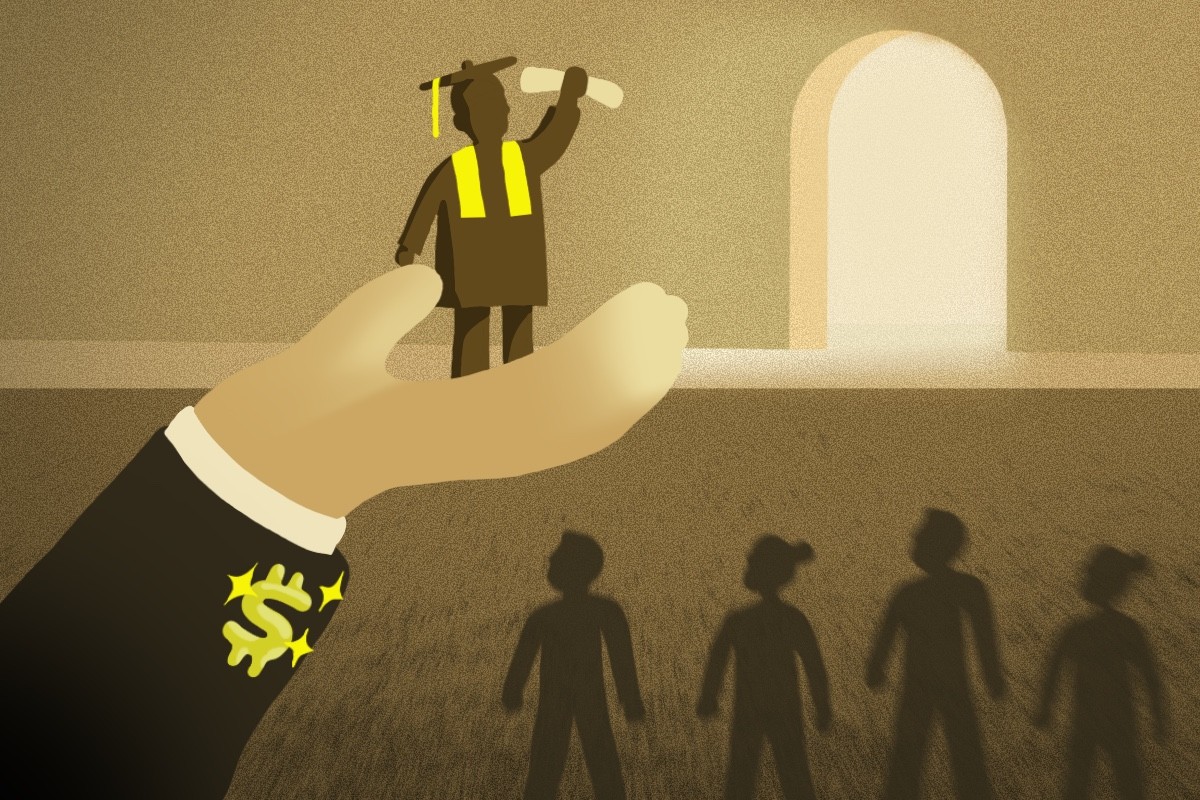Can Low Interest Rates Drive Inequality?
Professor Paymon Khorrami said years of declining interest rates may have led to higher investment in education by the wealthy, increased inequality, and worse economic outcomes
We are living through a half-century trend of declining interest rates. Despite headlines of high rates dominating the news since the Fed pivoted to a more restrictive policy in 2022, “real” interest rates — adjusted to inflation — have gone down on average since at least the 1980s.
This should be good news, as it's almost common sense to believe that low rates are unequivocally good for the economy.
However, research from Paymon Khorrami, an assistant professor of finance at Duke University’s Fuqua School of Business, may have found a link between lower rates, labor income inequality and lower economic outcomes.
In a new working paper, “Human Capital in a Time of Low Real Rates,” Khorrami and Jung Sakong, an economist at the Federal Reserve Bank of Chicago, argue that lower interest rates may have shifted the investments of wealthier families away from financial assets and toward their children’s education, a switch that may have led to higher income inequality and lower income mobility across generations.
The researchers hypothesized that parents think of their children’s education as part of a portfolio choice. “I can have two choices: I can leave my children with more financial bequests, or I can educate them more,” Khorrami said.
Khorrami said it is very difficult to prove causality between interest rates, educational investment, and inequality. However, data shows that as interest rates fell and rose in the two decades before the 1980s, “the rich versus poor educational investment gap mirrored this pattern” — the gap grew in the 1960s and fell in the 1970s, the research shows. Then, as interest rates and financial returns steadily declined over the course of the last 40-50 years, the rich-versus-poor educational investment gap continuously rose.
“The gap is moving in lockstep with interest rates, or the rate of return on financial investments, including stocks and bonds,” Khorrami said.
Wealthier families saw the higher returns of “human capital” investment, relative to financial assets, which led them to increase their investment in children's education, the researchers write.
In theory, Khorrami said, lower rates should make access to education easier for poorer families — think about borrowing for student loans.
But in reality, poorer families are hindered by “borrowing constraints”: even as interest rates decline, their access to credit (for education, in this case) doesn’t get much better, the researchers write.
“They would like to borrow more, but either the limits of government borrowing or the business model of banks — who base loans on your income, or your family income — cap the maximum poorer families can borrow,” Khorrami said. “It’s similar to what happens in housing.”
As a consequence, as the incentive for wealthier families to invest in their children’s education goes up, educational opportunities for poorer families remain the same or could even get worse, Khorrami said, because rising education demand of the rich can raise costs and “crowd out” educational attainment of the poor. For instance, as demand for college enrollment has outpaced the supply of slots, the cost of higher education increased in the United States.
“So poor families are constrained. And when you lower interest rates, their educational choices could actually be negatively affected,” he said.
The implications of low interest rates for inequality
The researchers found that over the course of the last 60 years, household investment in education generally increased (as a percentage of households’ total expenditures, including consumption). However, this education expenditure share grew much more for wealthier households than for poorer ones, they found.
The researchers built a model of a simplified economy with only parents and children. They assumed all parents want the best for their children. In the model, families have a trade-off: they can decide to leave their children with financial resources, or they can invest in their education. They can also decide how much they consume and how much they save. The model includes borrowing constraints, so that families with constraints can’t invest in education as much as they want, even if lower interest rates make borrowing more affordable.
The researchers found that declining interest rates, through the increased investment in education by wealthier families, may lead to a 17% increase of labor income inequality, as well as a 7% lower labor income mobility (meaning children’s income level correlates more strongly to their parents’ income).
“And you have to consider that our measure of educational expenditures excludes a lot of other things that you might want to include — let's say private music lessons, that are likely to increase children’s human capital, or time investment, that is parents investing more time in their kids, which is a very big one. And still, our limited measure shows that richer families are spending more on their kids,” Khorrami said.
Inequality in access to education may hurt economic outcomes
If borrowing constraints limit poorer families’ access to education, their children may be prevented from pursuing higher-paying jobs and the careers they have the talent to pursue, Khorrami said.
“Maybe the kid of a wealthy family shouldn't even be going to college. Maybe they would be fine just inheriting wealth and doing some kind of other occupation, while the poor family who has a smart kid is not investing enough,” he said.
Such inefficient distribution of resources to talented children leads to worse economic outcomes, the researchers write.
“Growth and efficiency can go down at the same time that inequality goes up,” Khorrami said.
Why have interest rates declined in the last 60 years?
Khorrami said several factors have led to declining interest rates. For starters, economic growth has been slowing, and lower growth usually leads people to save more to supplement their income — which drives down returns.
Similarly, demographic trends have caused people to live longer and save more for retirement, another factor that pushes down financial rates of return, he said.
He also said that a third factor may be “the global savings glut” — a term coined by Ben Bernanke in 2005 — or the influx of foreigners’ savings and investments in American financial assets, which may have contributed to driving down returns.
The restrictive policies enacted by U.S. and European central banks to combat inflation since 2022 haven’t reversed the historical trend, Khorrami said. “I don't think that interest rates are high right now. Historically speaking, they are not.”
As forces such as slowing growth, an aging population, and global savings are predicted to continue in the near future, the long-term interest-rate trend is expected to continue. Assuming the researchers’ findings are correct, inequality would rise further, an outcome that may concern policymakers, the researchers write.
The authors then ask whether a simple tax and redistribution tool could counteract the effects of low rates on inequality.
A capital or wealth tax could backfire, Khorrami said, because it would just lower the return on financial investments – which is exactly what drives higher educational investments by wealthy families, thereby increasing inequality.
The researchers suggest other policies, such as labor income taxes, may avoid this type of adverse side-effect on inequality.
“At the very least, you should match any tax with a redistribution scheme, where you collect revenue through the tax and then redistribute it to everyone,” he said. “But some taxes are preferable to others when you consider the link between interest rates and educational investment.”
This story may not be republished without permission from Duke University’s Fuqua School of Business. Please contact media-relations@fuqua.duke.edu for additional information.

